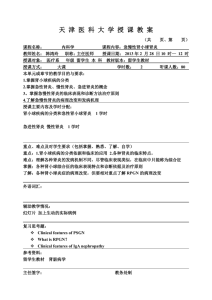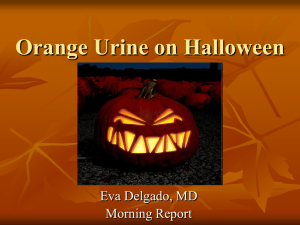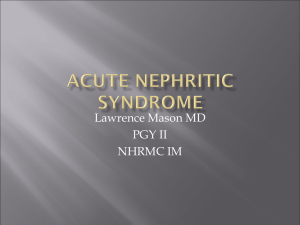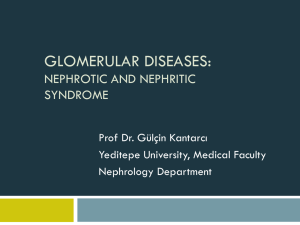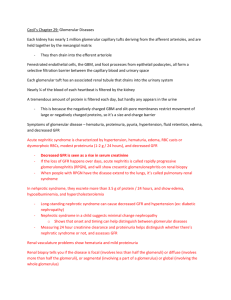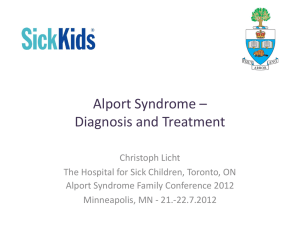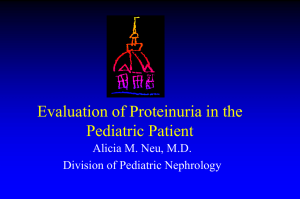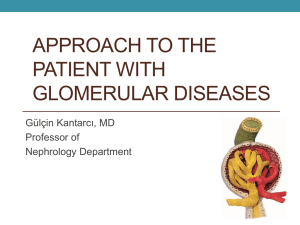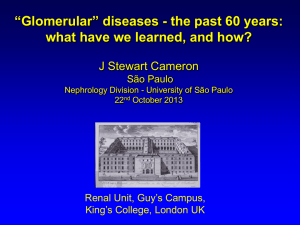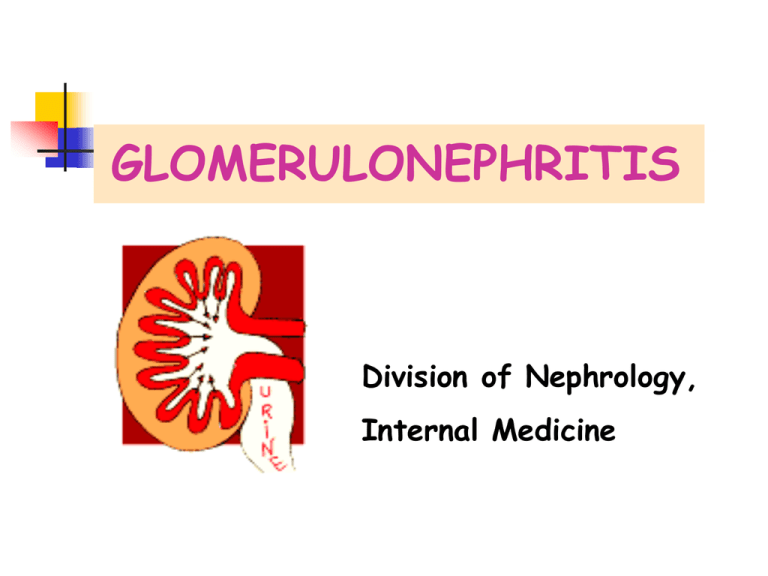
GLOMERULONEPHRITIS
Division of Nephrology,
Internal Medicine
Symptoms and Signs
Injury to the glomeruli
by various immunologic or
non-immunologic mechanism
Proteinuria
Hematuria
Edema
Hypertension
Azotemia
사구체신염의 분류
임상 증상에 따른 분류 ( 5 Syndromes)
1) 무증상성 요이상(AUA) : IgA N
2) 신증후군(NS) : MCD, FSGS, MGN
3) 급성 사구체신염(AGN) : PSGN
4) 만성 사구체신염(CGN) : IgA N, MPGN
5) 급속진행성 사구체신염(RPGN) : crescentic GN
원인 질환에 따른 분류
1) 속발성 사구체신염
HS nephritis, lupus nephritis,
DM nephropathy
Hepatitis B virus associated GN, PSGN
2) 원발성 사구체신염
MCD, FSGS, MGN, MPGN, IgA N,
Crescentic GN
병리학적(형태학적) 분류
NEPHROTIC SYNDROME
NS
Definition
Children : Serum albumin < 2.5g/dl
Proteinuria > 40mg/m2/hr
Adult : Massive Proteinuria
( >3g/24h/1.73m2)
Hypoalbuminemia
Edema
Hyperlipidemia
Anti-proteinuric Barrier
• Charge selective barrier :
negatively charged
sialoglycoprotein
• Size selective barrier :
44A(effective molecular
radius)
NS
NS
Classification
Primary NS :
MCD
FSGS
MGN
MPGN
Secondary NS :
Hepatitis B virus-associated GN
Lupus nephritis, Diabetic nephropathy
NS
Primary NS according to the age groups
Others
100%
FSGS
80%
MGN
60%
40%
MCD
20%
0%
15-20
21-30
31-40
41-50
51-60
60-
NS
Etiologic Diagnosis of Secondary NS (N=220)
Others
Renal amyloidosis
5.9%
Diabetic nephropathy : m/c
HBGN
46.8%
Lupus Nephritis
39.5%
Normal Kidney (1)
H&E stained section
Normal Kidney (2)
Minimal Change Disease
(MCD)
Synonyms : Nil disease, Lipoid nephrosis
Foot process disease
Incidence : male>female
80% of NS in children
20-40 % of NS in adults
Cause : Drug (NSAIDs, rifampin, interferon a)
Hodgkin’s disease, HIV infection
Pathology : normal in LM, IF
epithelial foot process effacement in EM
MCD
Treatment
Highly steroid responsive, excellent prognosis to
glucocorticoid therapy
90% (children) and 50% (adult) : remission after
8weeks of high dose steroid therapy
sometimes relapse upon tapering (50-70%)
Alkylating agents are reserved for frequent
relapsers, cyclosporine for steroid resistant MCNS
MCD
LM
EM
FSGS
• 특발성 신증후군의 10% 정도 차지,
• 원인 : 특발성, heroin abuse, VUR, AIDS,
solitary kidney
• 임상 양상 : 대부분 전형적인 신증후군(nonselective)
고혈압, 혈뇨, 신기능 저하
• 병리 : 비증식성, 경화성 변화
(초점성, 분절성)
면역 형광 소견은 비특이적
• 치료 : 장기간의 steoid 치료,
steroid 에 대한 효과가 낮음
• 예후 : 50% 환자가 7-10년에 ESRD 로 진행 ,
신이식 후에도 재발 흔함
FSGS
LM
Membranous Nephropathy
MGN
1. Most common idiopathic NS in adults (40%)
Rare in children
Peak incidence between 30 and 50
2. Clinical manifestation
Mostly nephrotic (80%), Nonselective proteinuria
Microhematuria (50%)
HT : less than 30% at initial manifestation
but common later with renal progression
MGN
Pathology
LM : diffuse thickening of the GBM (PAS staining)
spike pattern (Silver staining)
IF : granular deposit of IgG, IgM, C3
EM : subepithelial electron dense deposit
stage I, II, III, IV
MGN
Etiology
Idiopathic (majority)
Systemic disease or drugs
1. Infection : hepatitis B, hepatitis C
2. Autoimmune disease : SLE, RA, MCTD
3. Malignancy : carcinoma
4. Drugs : gold, penicillamine, NSAID, captopril
5. Miscellaneous : sarcoidosis, DM,
MGN
Clinical Sx
① Mean onset age: 30 ∼ 50 age (male: female = 2:1)
② Older age: correlate with malignancy 20% (>60 age)
③ Massive proteinuria (80%), edema
④ RVT*: 50% - high incidence
MGN
Treatment & Prognosis
40% : spontaneous remission
30-40% : repeated relapse and remission
10-20% : persistent NS and progressive azotemia
(ESRD in 20 to 30 years)
Risk factors of renal progression :
male, older age at onset, heavy proteinuria,
hypertension, stage IV lesion, azotemia at initial Bx
Tx : no therapeutic effect with steroid alone
cyclophosphamide, chlorambucil, cyclosporine
MGN
LM
IF
IF with antibody to IgG.
EM
MGN
deposition of electron dense material and
interposition of lighter GBM materialsubepithelial deposition
Membranous Proliferative
Glomerulonephropathy
Type I: Subendothelial Deposits Type II: Dense Deposit Disease
MPGN
EM
Type I: Subendothelial Deposits
Type II: Dense Deposit Disease
MPGN
Clinical Manifestation
Variable combination of nephritic or nephrotic
features
Common in ages between 5-30
Decline in GFR, active urine sediment,
Proteinuria often in nephrotic range (50%)
Type I MPGN : Immune complex disease
C3 usually depressed
C1q, C4, properdin, factor B : borderline or low
Secondary MPGN : associated with infection, SLE,
malignancy
MPGN
Pathology
Diffuse proliferation of mesangial cells
Increased mesangial matrix
Thickening and reduplication of GBM
(Double contour, Tram-tract)
Type I and type II MPGN
Prognosis
Poor, slow progression to ESRD
Worse in type II MPGN
MPGN
LM
Normal kidney
MPGN
EM
IF
Acute Glomerulonephritis or
Acute Nephritic Syndrome(AGN)
AGN
Acute glomerular inflammation
Sudden onset of acute renal failure and oliguria
Obstruction of glomerular capillary lumen
GFR falls
Na and water retention
ECF volume expansion, Edema, Hypertension
U/A : RBC cast, dysmorphic RBC, leukocytes,
subnephrotic proteinuria
Often gross hematuria
Azotemia
General pathologic feature :
proliferative GN (capillary endothelial cell, mesangial cell)
PSGN
AGN - PSGN
Acute post-streptococcal GN
Etiology : Pharyngeal or cutaneous infection with group A
beta-hemolytic streptococcus, nephritogenic strain
Epidemiology : common in children, male > female
Latent period : 6-15 days (“post-pharyngitic”)
Hematuria (gross or microscopic),
Edema, mild HT,
Oliguria,
Nausea, mild fever,
Flank pain
ARF of variable degrees
PSGN
Lab finding & Pathology
U/A : hematuria, mild proteinuria
GFR reduced
Elevated ASO, anti-hyaluronidase, elevated anti-DNase B
Culture: Streptococcus in throat or skin
Complement level :
C3, CH50 markedly reduced, normalized in 8 weeks, C4 mildly
reduced
LM : Diffuse endocapillary proliferation
PMN cell and monocyte infiltration
EM : hump (large subepithelial deposit: characteristic)
IF : IgG, C3 deposit
PSGN
Treatment & prognosis
Benign course in children
Acute symptom : relieved in 1-2 wks
U/A abnormality esp. hematuria persists for 2 years
Treatment : symptomatic
Rest, salt water restriction, diuretics, protein
restriction
Antibiotics (PCN, EM) needed in limited cases
- i.e. incomplete treatment, elevated CRP
PSGN
LM
IF
PSGN
EM
Asymptomatic Urinary Abnormality
(AUA)
Hematuria or subnephrotic proteinuria
without HT, renal insufficiency, edema
U/A abnormality : persistent or recurrent
Hematuria with or
without proteinuria
IgA Nephropathy
Thin basement
membrane disease
Alport syndrome
Isolated non-nephrotic
proteinuria
Orthostatic proteinuria
MN, FSGS, DM,
amyloidosis
IgA Nephropathy
IgAN
Most common GN worldwide (10-40%)
Etiology : most cases are idiopathic
Clinical spectrum with Henoch-Schonlein Purpura
Secondary IgA N due to liver cirrhosis, Crohn’s disease
Epidemiology : between 16 and 35 years, male>female
Initial manifestation
Recurrent gross hematuria, often 24 to 48h after pharyngitis,
GI infection (“synpharyngitic”)
Or, microscopic hematuria during routine examination
HT, nephrotic proteinuria rare at initial presentation
IgAN
Lab : Elevated serum IgA level in 50% cases,
circulating IgG or IgA Immune complex
Prognosis
20 to 50% progress to ESRD over 20 years
Poor prognosis group :
- Male sex
- Older age at onset
- Absence of gross hematuria
- heavy proteinuria
- Hypertension
- azotemia at initial diagnosis
IgAN
LM
mesangial expansion with increased matrix and cellularity
IgAN
Mesangial deposits of IgA
Subendothelial and subepithelial
deposits are rarely seen.
AUA : Isolated Non-nephrotic Proteinuria
of Glomerular Origin
Orthostatic Proteinuria
Persistent Proteinuria
Dx : separate urine
collection(7A-11P, 11P7A)
Prognosis : excellent
Etiology : smoldering GN (mild
mes. Prolif. GN, FSGS,
focal or diffuse prolif. GN),
interstitial nephritis
Prognosis : slowly progressive
azotemia
Rapidly Progressive
Glomerulonephritis (RPGN)
Crescent
Normal
glomerulus
•Patchy parenchymal consolidations are present, which usually are
•bilateral, symmetric perihilar, and bibasilar.
•The apices and costophrenic angles usually are spared
RPGN
RPGN
Subacute glomerular inflammation
Patient develop renal failure over weeks to months
Nephritic urinary sediment, subnephrotic proteinuria,
oliguria, HT, hypervolemia, edema
Renal biopsy almost invariably shows crescents
(=Crescentic GN)
RPGN
Crescentic GN
Pathology : diffuse crescent formation > 50%
glomeruli
Clinically : progression to renal failure over weeks
to months, clinical features of GN (proteinuria,
hematuria, active urinary sediment)
If not properly treated, end stage renal disease
ensues in 80-90%
RPGN
Classification of Crescentic GN
Type I : anti-GBM disease without pulmonary
hemorrhage
Type II : Immune complex deposition
Type III : pauci-immune
(no immunoglobulin deposition)
ANCA (anti-neutrophil cytoplasm antibody) 양성
RPGN
C-ANCA on ethanol fixed slide
C-ANCA is identified as a positive result when there is intense
positive granular staining of the
cytoplasm that extends to the border of the human granulocyte substrate displaying a 1+ or greater fluorescence
and there is absence of nuclear staining
P-ANCA on ethanol fixed slide
P-ANCA exhibits intense positive perinuclear staining of the multi-lobed nucleus with a poorly defined cell
border.
A 1+ or greater fluorescence is considered a positive result
LM
RPGN
IF
IF with antibody to fibrinogen.
RPGN
There is a linear pattern of staining along the
glomerular basement membrane with IgG.
Alport’s Syndrome
Genetic defect in type IV collagen
Alpha 5 chain
X-linked dominant
Ant. lenticonus
Sensorineural hearing loss
Recurrent hematuria
Slowly progress to ESRD
EM : thickenend GBM with
lamellation, splitting
Thin Basement Membrane Disease
(= Benign familial hematuria)
Chronic Glomerulonephritis (CGN)
Persistent proteinuria/hematuria/HT
Insiduous onset, slowly progressive renal
insufficiency over years
Can be a manifestation of virtually all of the
major GNs
Pathology : renal atrophy, cortical thinning,
glomerulosclerosis irrespective of causative GN
Secondary GN
Lupus Nephritis
Systemic Vasculitis
Amyloidosis
Cast Nephropathy
Lupus Nephritis
Lupus Nephritis -- Diffuse Proliferative
Amyloidosis
Nodular pattern
apple green on polarized light
Randomly oriented thin fibrils
(EM: x 51,250)
Cast Nephropathy
T-H protein(cast)
Diagnostic Approach to GN
Etiologies of AUA
Hematuria with or
without proteinuria
Isolated non-nephrotic
proteinuria
IgA Nephropathy
Thin basement
membrane disease
Alport syndrome
Orthostatic
proteinuria
MN, FSGS, DM,
amyloidosis
1. Clinical feature가 사구체신염인가?
Proteinuria, Hematuria, Edema, Hypertension,
Azotemia(PHEHA)
Hematuria of glomerular origin :
dark color, no clot formation, RBC cast, dysmorphic
RBC,
overt albuminuria/proteinuria(>1g)
Pathologic proteinuria of glomerular origin :
not orthostatic but persistent proteinuria, mainly
albuminuria on urine PEP,
accompanied by glomerular hematuria
2. 사구체신염의 임상증후군 가운데 어디에
해당되는가?
NS
AGN
RPGN
CGN
AUA
Physical Exam : BP, edema
U/A : RBC cast, WBC cast,
oval fat body
24H urine collection
for protein quantitation
Blood Chemistry: protein/albumin
cholesterol, BUN/Cr
Serial Check of BUN/Cr
Kidney sono : renal size,
echogenecity
3. 사구체신염을 일으키는 원인질환이 있는가?
Age/Sex
History : URI, family Hx
Physical exam : skin rash, purpura, skin infection,
arthritis, oral ulcer
X-ray : pulm.hemorrhage, arthritis
Hepatitis B, C, HIV, VDRL, FTA-ABS
ASO, anti-DNase B, CRP, cryoglobulin, RA factor,
FANA, anti-dsDNA, C3/C4 level, ANCA, anti-GBM
antibody
Serum complement가 감소하는 질환
Idiopathic GN
Secondary GN
Acute PSGN,
MPGN type I, II
Lupus nephritis,
GN secondary to SBE,
Cryoglobulinemia
4. 사구체신염 진단을 위해 신생검이 필요한가?
GN의 원인적 진단이
이루어진 경우
GN의 원인이 명확하
지 않는 경우
진단명
조직형태와 무관하게 조직 형태에 따라 진
원인에 따라 진단명을 단. 예> idiopathic
MN, MPGN, IgA N
붙인다. 예> Lupus
nephritis, hepatitis B
associated GN
신생검을
하는 목적
질환의 신침범 정도와 형태학적 진단 및 진
그에 따른 예후 파악
단에 따른 예후 파악
Renal Biopsy
Renal biopsy provides tissues that can
be used to determine the diagnosis,
indicate the cause, predict the
prognosis, direct treatment and collect
data for research.
Renal Biopsy
Indication
1. The cause cannot be determined or predicted by less
invasive techniques
2. Signs and symptoms suggest parenchymal disease
that requires pathologic evaluation
3. DDx includes diseases that have different
treatments or different prognosis
Renal Biopsy
Usually Needed in
Nephrotic syndrome in adults
Steroid resistant NS in children
GN in adults other than clear-cut PSGN or lupus
nephritis
ARF of unknown cause
RPGN
Activity or chronicity determination of lupus
nephritis
Renal Biopsy
Method
Localization of kidney by real-time ultrasound
Biopsy needles : Vim-Silverman,
Gun biopsy needle
(spring loaded disposable gun needle)
1-1.5cm length cortical tissue needed
Visualized under LM, FM and EM
Renal Biopsy
Renal Biopsy
Renal Biopsy
Renal Biopsy
Renal Biopsy
Complications
Small perirenal hematoma : common
Gross hematuria (< 10%)
AV fistula (< 1%)
Massive bleeding that requires surgery (< 1%)
Mortality (< 0.1%)
Renal Biopsy
Contraindication
Uncooperative patient
Solitary Kidney
Uncontrolled severe hypertension
Bleeding tendency
Severe anemia or dehydration
Cystic kidney
Hydronephrosis
Multiple renal a. aneurysms
APN, perinephric abscess, renal neoplasm
Sclerotic kidney, ESRD

